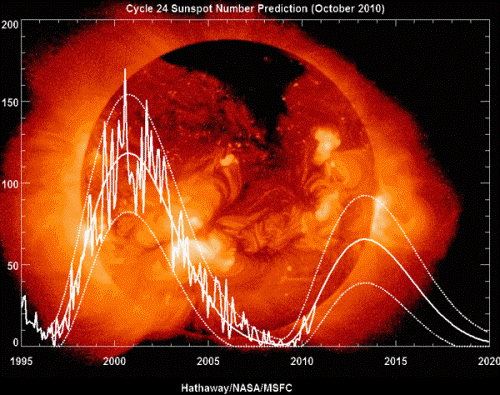Surf’s up big time on the Sun, or just above the sun, in this case. Seems like NASA’s high resolution Solar Dynamics Observatory (SDO) has caught conclusive evidence of classic “surfer waves” in the solar atmosphere — looking just like the kind in the opening sequence of ‘Hawaii Five-O’.
On Earth, so-called “giant waves” of up to 60 feet in height have been surfed. But “giant” is relative: on the sun the observed waves are roughly the size of the continental U.S. But just like a surfer wave on Earth, the solar counterpart is formed by the same fluid mechanical phenomenon known as a Kelvin-Helmholtz instability.
If you’re into this, you’ll probably also love –>> Large Solar Flare Erupts with ‘Spectacular’ Coronal Mass Ejection {VIDEO}
Whenever to fluids of differing densities or speeds pass by each other, an “instability” arises (a wave form emerges), as small ripples get amplified into bigger and bigger waves. This is also known as turbulence. In the case of earth-bound, surfer waves, the two fluids are the ocean surface and the air current above it.
On the sun, the two fluids are two plasmas — expanses of super hot, charged gases — interacting: one that is erupting from the surface and shooting past a second plasma that is not erupting. The resulting turbulence is a Kelvin-Helmholtz (KH) wave form.
The “froth” that builds up at the top of a surfer wave as it curls increases friction between the two layers. The friction builds and transfers heat energy to the wave, propelling the the wave and making it grow.
Watch the NASA/GSFC SDO video of the surfer wave below or larger on NASA’s website
So, the Kelvin-Helmholtz instability is resolved by a large transfer of energy (heat) from one layer to the other — what a typical surfer dude doesn’t usually feel, as the heat energy dissipates through the water quite rapidly. The astrophysical team speculates that these waves on the sun are the result of friction between plasma fields, and thus possibly transferring the heat into the sun’s atmosphere.
Detection of these waves “on” the sun, or rather, in the solar corona, gives solar physicists a clue to the mysterious heat transfer from the sun to its atmosphere; what may account for the fact that the solar corona is a thousand times hotter than the sun’s surface temperature. Why and how this difference should be has been a long-standing puzzle.

Although surfer waves have been spotted in other places in the solar system — such as in the Earth’s cloud system and between the bands of Saturn — such waves are rarely spotted. This was the first time such waves have been seen on the Sun (and coming so soon after SDO’s launching in Feb. 2010). Some scientists have held that such instabilities would be prevented, or limited, by the solar corona’s myriad magnetic fields, which tend to keep these things in check.
To lend support to their finding, the team constructed a computer model to see what could happen in that region of the sun’s atmosphere. The results of the running the simulation confirmed that Kelvin-Helmholtz waves could indeed arise. They also suspect that the turbulence here can work in reverse — moving from the large waves all the way down to the smallest of ripples.
This discovery is helping scientist to better understand the corona; what’s heating it so much and how it’s happening, and why is this so important.
Well, there’s one last piece of the puzzle: what caused the instability in the first place?

Solar physicists are pretty sure that the cause was a Coronal Mass Ejection (CME; see image). Such CMEs occur when the sun seems to “cast off” its outer atmosphere, violently propelling massive amounts of high-speed plasma particles millions of miles into outer space. When they reach Earth in about 7 minutes (note: light reaches the Earth in 7nminutes, the plasma takes quite a bit longer), these CMEs can make the space above the Earth unsafe for astronauts and satellites alike. They can also cause major disruptions in utility grids and communication systems down here on the surface.
So, knowing more about the how the corona is heated — and the conditions that prevail there just before the surfer waves form (indicating a CME) — might give scientist a means of predicting the next CME, and thus taking steps back here on Earth to protect ourselves before the blast’s plasma hits.
Aside from that, it’s just gnarly science.
Photos and Video: NASA/GSFC


